Understanding the Importance of a Medical Assistant Cover Letter
A well-crafted cover letter is your first opportunity to make a positive impression on a potential employer. For medical assistant students, it’s especially crucial. It’s not just a formality; it’s a chance to showcase your personality, enthusiasm, and the unique skills you bring to the table. In a competitive job market, a strong cover letter can set you apart from other applicants and increase your chances of landing an interview. It provides context to your resume, allowing you to elaborate on your qualifications and explain why you are the ideal candidate. A cover letter lets you speak directly to the hiring manager, demonstrating your communication skills and attention to detail, essential traits for a medical assistant.
Why a Cover Letter is Crucial
Resumes provide a snapshot of your experience and education, but a cover letter allows you to tell a story. It explains your career goals, why you’re interested in the specific position, and what you hope to achieve. A cover letter lets you highlight the skills and experiences most relevant to the job requirements. It’s also an opportunity to demonstrate your understanding of the healthcare industry and the specific needs of the practice. Moreover, a cover letter reveals your communication style and professionalism. It shows that you are taking the application process seriously and are willing to put in the extra effort to make a strong impression. This proactive approach can significantly increase your chances of getting an interview and eventually securing the job.
Highlighting Skills and Experience
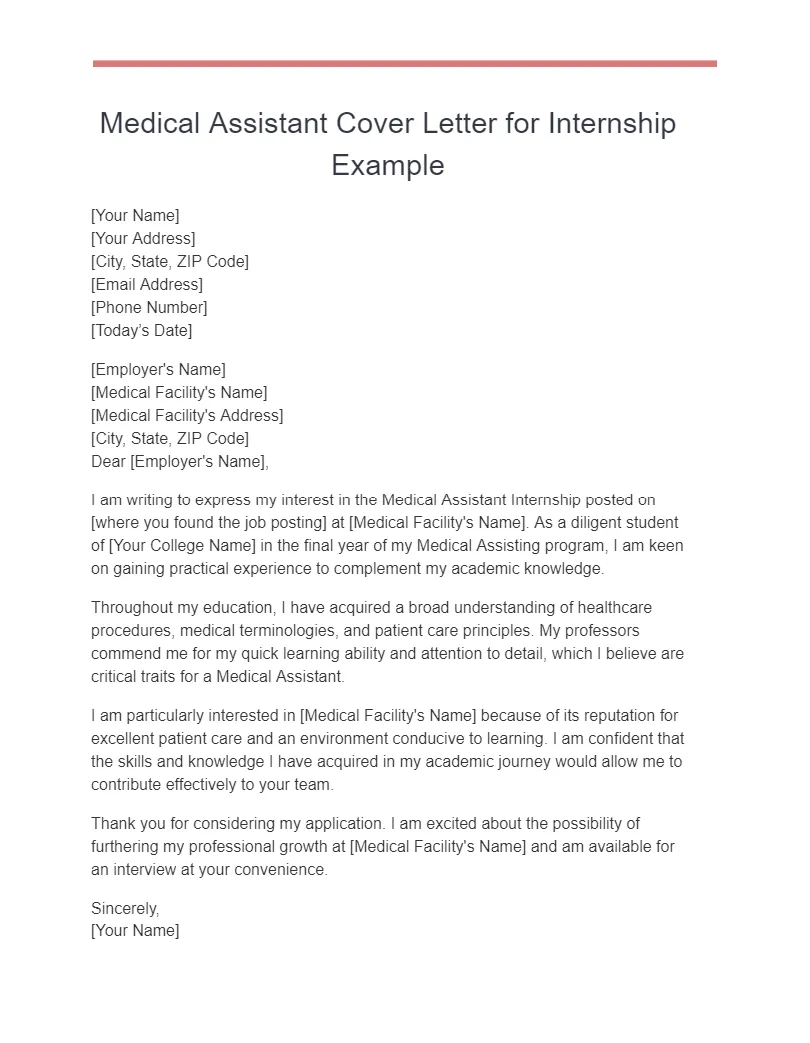
In a cover letter, you can spotlight the skills and experiences that directly relate to the medical assistant position. Even as a student, you likely have relevant experiences, such as clinical rotations, volunteer work, or any healthcare-related jobs. Use the cover letter to emphasize the skills you’ve acquired. For example, if you’ve developed strong patient communication skills or proficiency in taking vital signs, be sure to mention these skills and provide specific examples of how you’ve used them. Remember to tailor your cover letter to each job application, highlighting the skills and experiences that align with the job description’s requirements.
Key Components of a Strong Medical Assistant Cover Letter
A strong cover letter consists of several key components. These elements work together to create a compelling introduction, a persuasive body, and a professional conclusion. Each part of the cover letter plays a crucial role in conveying your qualifications and enthusiasm. Make sure you include all these points and adapt them accordingly to the job you are applying for. Let’s break down each component to ensure your cover letter stands out.
Header Information
The header is the first thing the hiring manager sees. It should include your contact information and the date. Ensure that the header is neatly formatted and easy to read, as this sets the tone for your entire application. Also, make sure the date is current, indicating your application is timely. This immediate display of professionalism can significantly influence the hiring manager’s initial perception of you.
Applicant’s Contact Information
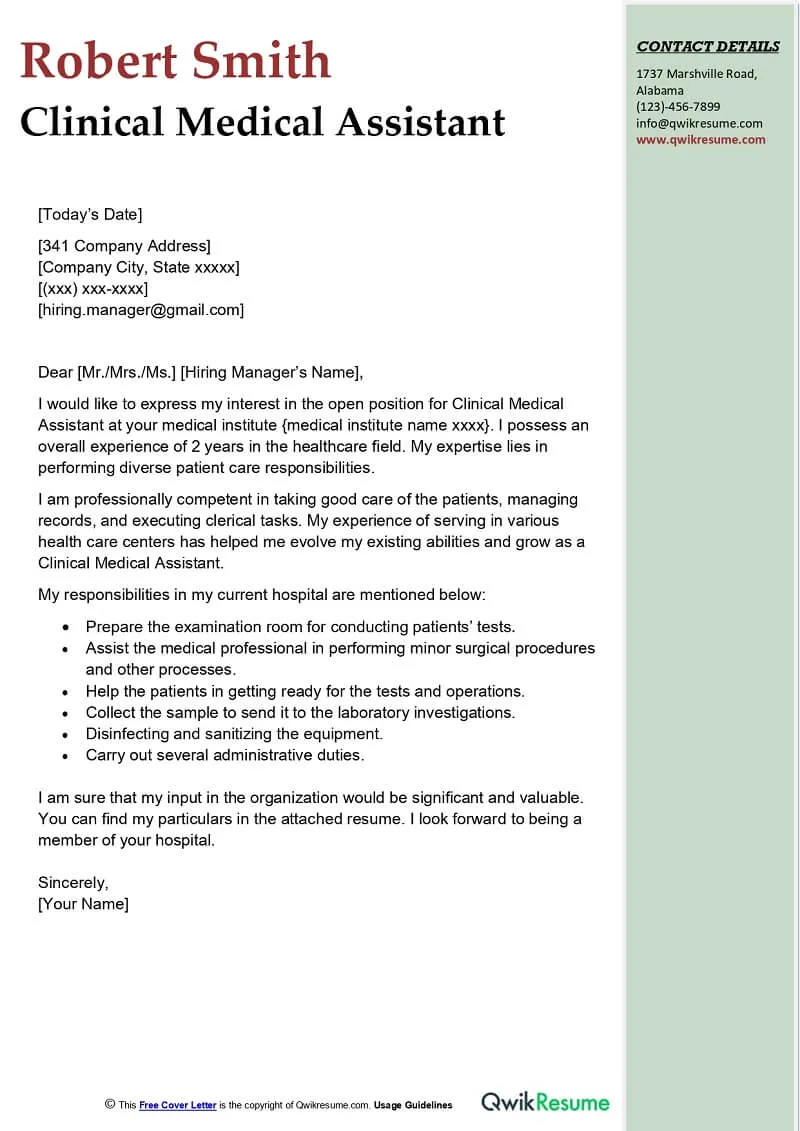
Include your full name, address, phone number, and a professional email address. It’s essential to use a professional-sounding email address (e.g., john.doe@email.com) rather than a casual one. Make sure your phone number is one where you can be easily reached, and that the voicemail is professional. Also, double-check all the information to ensure there are no typos or errors, as this reflects your attention to detail.
Date
Place the date directly below your contact information. This shows when you submitted your application, which is useful for the employer’s records. The date also indicates to the employer that the cover letter is current and relevant. Make sure the date format is consistent with the style of the rest of the document and appropriate for the region.
Hiring Manager’s Contact Information
If you know the hiring manager’s name, address your letter to them directly. This personalized approach shows that you have done your research and are genuinely interested in the position. If you can’t find the hiring manager’s name, use a general title, such as ‘Hiring Manager’ or ‘Recruiting Team.’ Always double-check the spelling of the name and title to ensure accuracy.
Salutation
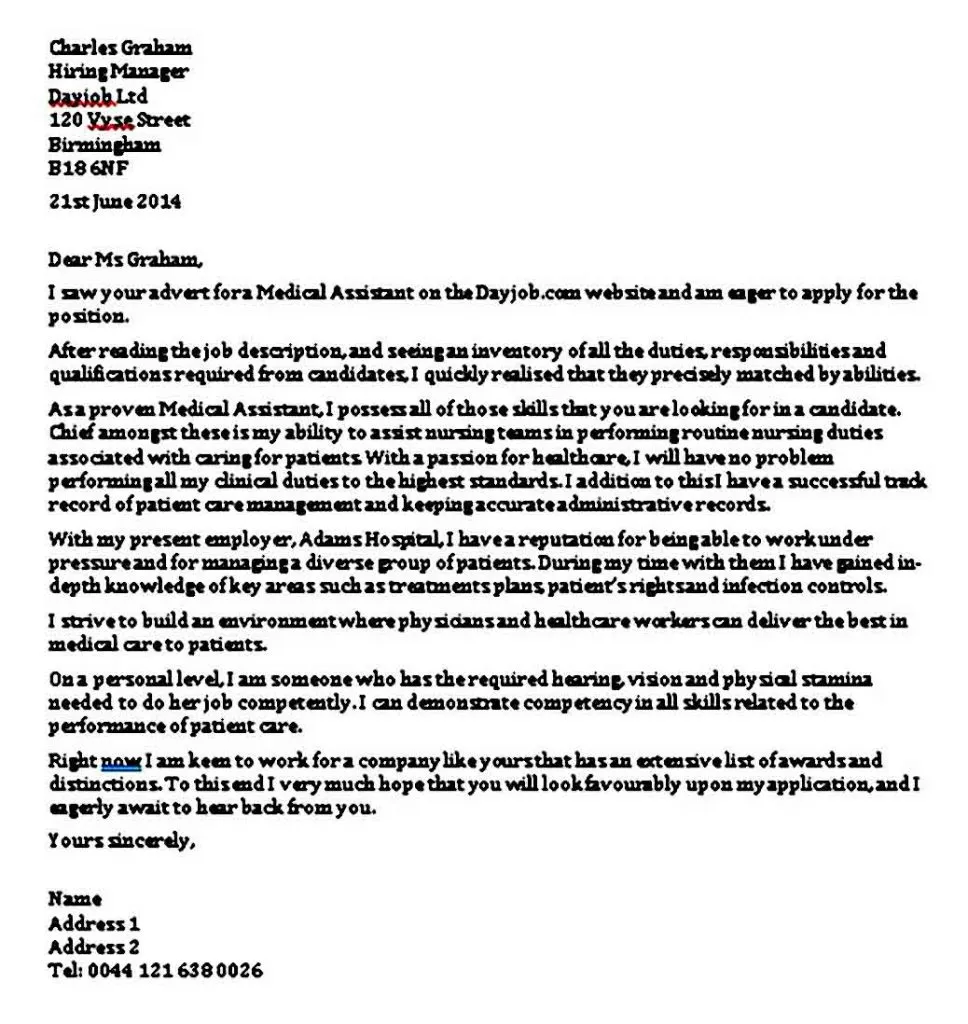
Start your cover letter with a professional salutation, such as ‘Dear Mr./Ms./Dr. [Last Name]’ or ‘Dear Hiring Manager.’ Avoid informal greetings like ‘Hi’ or ‘Hello.’ If you are unsure of the person’s name, using a professional salutation sets the tone for a formal correspondence, indicating respect and seriousness.
Body Paragraph 1: Introduction and Purpose
In the first paragraph, state the position you are applying for and how you found the job listing. Briefly mention your interest in the role and the organization. This paragraph serves as an introduction, clearly stating your intention and setting the context for the rest of the letter. Make your opening sentence engaging and specific, grabbing the reader’s attention and making them want to read more about your candidacy. Clearly state the position you are applying for and the source of the job posting.
Body Paragraph 2: Showcasing Skills and Qualifications
This paragraph is where you highlight your skills and qualifications. Focus on the skills and experiences most relevant to the job description. Provide specific examples that demonstrate your abilities, quantifying your achievements whenever possible. It’s a good idea to emphasize your achievements. Make your language concise and compelling, ensuring the reader understands the value you bring to the role. Consider including keywords from the job description to show you meet the job’s criteria.
Relevant Clinical Skills
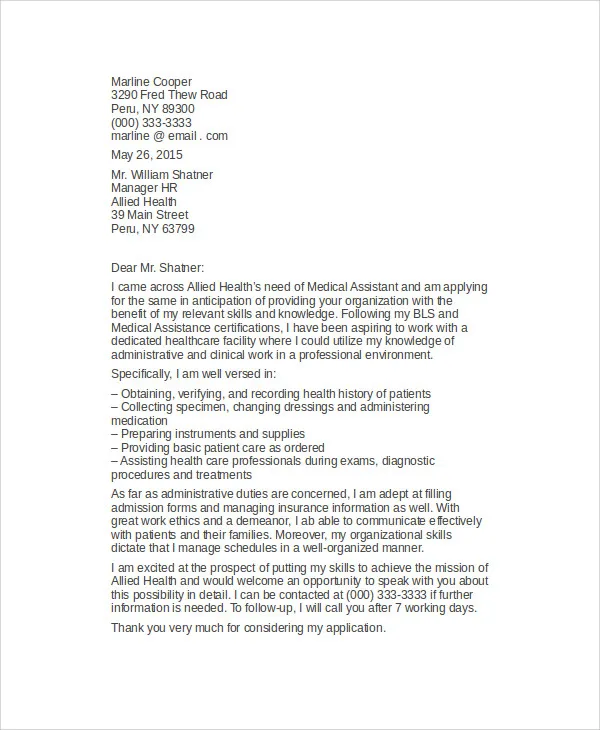
Mention any clinical skills you have acquired. These may include taking patient histories, measuring vital signs, assisting with examinations, and performing basic lab procedures. For each skill, provide a brief example. For example, ‘During my clinical rotation, I consistently took accurate vital signs for over 30 patients daily, ensuring precise documentation and contributing to effective patient monitoring.’ Demonstrating your clinical competence is essential for the position.
Patient Care Abilities
Highlight your patient care abilities. This could include communicating with patients, explaining procedures, providing emotional support, and ensuring patient comfort. Give specific examples of your interactions with patients. For instance, ‘I have experience in creating a welcoming environment and effectively communicating with patients from diverse backgrounds, ensuring they feel comfortable and informed during their appointments.’ Emphasizing your patient care skills showcases your ability to provide holistic care.
Administrative Skills
Describe any administrative skills, such as scheduling appointments, managing patient records, handling insurance, and using electronic health record (EHR) systems. Provide evidence of how you’ve utilized these skills. For example, ‘I am proficient in using [EHR system name] to schedule appointments, update patient information, and manage billing, streamlining administrative processes effectively.’ Highlighting these abilities showcases your administrative support skills, which are crucial in a medical setting.
Body Paragraph 3: Demonstrating Enthusiasm and Fit

In the third paragraph, demonstrate your enthusiasm for the position and the organization. Explain why you are interested in working at this specific practice. Mention what attracts you to the organization’s values, mission, or approach to patient care. Showing that you have researched the organization and are aligned with its goals indicates your genuine interest. Tailor this section to reflect the specific values and mission of the practice.
Use statements that convey your passion for the healthcare field and your dedication to providing quality care. Mention any professional goals. Show how the role aligns with your career aspirations and highlight the value you can bring to the team. Express your eagerness to learn and grow within the organization, further solidifying your enthusiasm.
Body Paragraph 4: Call to Action and Closing
End your cover letter with a call to action and a strong closing. State that you are available for an interview and provide your contact information again. Thank the hiring manager for their time and consideration. The call to action encourages the hiring manager to take the next step and invites them to contact you. Reiterate your enthusiasm for the position and your belief that you are the best fit for the job.
Complimentary Close
Use a professional closing such as ‘Sincerely,’ ‘Best regards,’ or ‘Thank you.’ Ensure the closing is consistent with the tone of your letter. Your closing should be polite and professional, leaving the reader with a positive impression. Make your closing concise and appropriate.
Signature
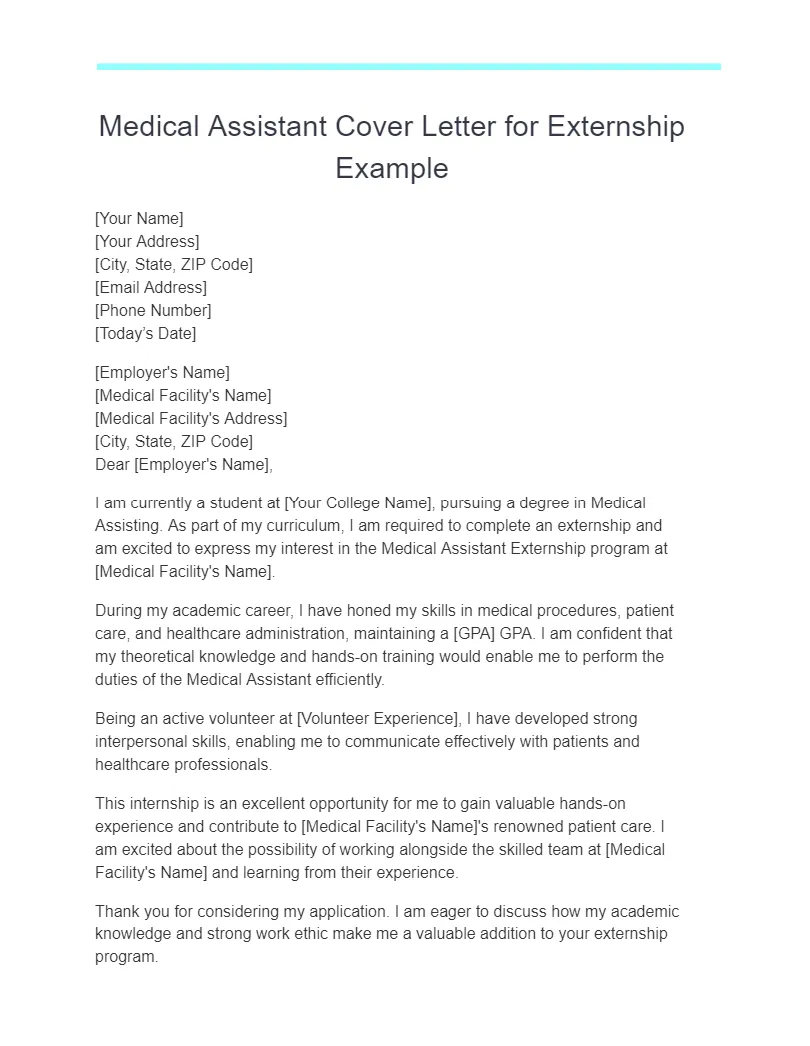
Leave space for your handwritten signature if you are printing and mailing the letter. If submitting electronically, type your full name below the closing. Your signature adds a personal touch and reinforces your professional approach.
Proofreading and Editing
Before submitting your cover letter, carefully proofread and edit it for any errors in grammar, spelling, and punctuation. Errors can create a negative impression. Ask a friend, career advisor, or professor to review your letter for feedback. Ensure the content is clear, concise, and easy to understand. Review the format and ensure it is consistent throughout. A polished cover letter shows attention to detail and professionalism.
Essential Tips for Medical Assistant Students
As a medical assistant student, you can implement some strategies to write an impressive cover letter. Focusing on these points helps you tailor your cover letter to the needs of employers and makes the letter more appealing. Take a proactive approach to your cover letter preparation. It is a key piece of your application, so it must be well-crafted and impactful.
Tailoring Your Cover Letter
Customizing your cover letter for each job application is essential. Read the job description carefully and identify the key requirements. Align your skills, experiences, and qualifications with the employer’s needs. Modify your letter to highlight the most relevant aspects of your profile. This shows that you have carefully considered the position and are not submitting a generic application. Using keywords from the job description and providing relevant examples makes your application more appealing to the hiring manager.
Using Action Verbs
Begin your sentences with strong action verbs to make your cover letter more impactful and dynamic. Action verbs showcase your accomplishments and make your descriptions more engaging. For example, instead of saying ‘I was responsible for taking vital signs,’ you could write, ‘I accurately recorded vital signs for over 30 patients daily.’ Use action verbs throughout your cover letter to describe your skills and contributions. This approach can give your letter a more active and professional tone.
Quantifying Achievements
Whenever possible, quantify your achievements to show the impact of your contributions. Use numbers, percentages, and specific data to demonstrate your skills and accomplishments. For instance, you could state, ‘Improved patient satisfaction scores by 15% by implementing a new communication strategy.’ Using specific details provides concrete evidence of your capabilities. By including numbers, you provide the hiring manager with a clear sense of your capabilities and the value you bring to the role.
Highlighting Certifications and Training
Ensure that you mention any certifications, training, or licenses you have obtained. Include details about your educational background, such as the name of your program, your expected graduation date, and any relevant coursework. If you have certifications, like CPR or medical assisting certifications, mention these to show your competency. Include any specialized training, clinical rotations, or skills you have acquired during your program. Highlighting these credentials shows you meet the basic requirements for the role.
Formatting Your Cover Letter
Formatting plays a critical role in how your cover letter is perceived. Professional formatting will help the employer easily read the document. Ensure your cover letter is easy to read, well-organized, and visually appealing. Follow these formatting guidelines to make the letter more effective and professional.
Dos and Don’ts
Here’s a quick guide to what to do and avoid: Do: use a professional font (e.g., Times New Roman, Arial), use single-spaced lines with a space between paragraphs, keep the letter concise and focused (ideally one page), proofread carefully, and tailor the letter to each job application. Don’t: use slang or informal language, include irrelevant information, make grammatical errors, submit a generic cover letter, and exceed one page in length.
Medical Assistant Cover Letter Template Examples
To assist you in creating your cover letter, here are some template examples to help you get started. You can use them to guide your writing process. Always adapt them to reflect your unique skills and experiences, customizing each letter. These templates provide a base structure that helps you organize your thoughts and present your qualifications clearly. Here are a few examples.
Entry-Level Cover Letter Example
This template is for medical assistant students or recent graduates with little professional experience. The main focus should be on your education, clinical rotations, and any volunteer work. Highlight relevant skills, such as patient care, administrative tasks, and proficiency with medical software. Be sure to emphasize the skills you have learned and your willingness to learn and adapt. Highlight any coursework, projects, or extracurricular activities that demonstrate your relevant abilities and interests in the field.
Cover Letter for Externship or Internship
For externships or internships, emphasize your desire to gain practical experience and learn from professionals. Highlight your enthusiasm for working in a clinical setting. Mention the specific skills and knowledge you hope to acquire during the internship. Clearly outline the specific goals you have for your internship. Express how this opportunity aligns with your career goals and what you hope to gain from the experience. Explain why you chose their organization for your internship.
Cover Letter for Specific Medical Practices
If you’re applying to a specific type of medical practice (e.g., a cardiology clinic, a pediatric office), tailor your cover letter to showcase relevant experiences. Highlight the skills and experiences related to the specialty. Mention your interest in the practice’s specific services, approach to patient care, and any specialized skills. Indicate how your skills align with the clinic’s needs, demonstrating your understanding of the practice’s services. Show your interest in a specific practice and the specialized knowledge you possess.
Frequently Asked Questions
Here are answers to some common questions about medical assistant cover letters. It can help you address any concerns you may have and make sure that your cover letter is effective.
What if I have no experience?
If you lack professional experience, emphasize your education, clinical rotations, and any volunteer work. Highlight your eagerness to learn and your commitment to providing excellent patient care. Highlight any relevant coursework or projects. Show how you’re dedicated to the medical field. Focus on what you’ve learned during your training and how it translates into the skills required.
How long should my cover letter be?
Your cover letter should be one page long. This length is sufficient to provide all of the relevant information without overwhelming the reader. Keep the letter concise and focused. Ensure that your letter communicates your qualifications and enthusiasm effectively.
Should I include references?
Typically, you do not include references directly in your cover letter. Instead, you can state, ‘References are available upon request.’ It’s also acceptable to include your references in a separate document and provide it if requested. Always have your references prepared before submitting your application.
Conclusion
A well-crafted cover letter is an essential tool for medical assistant students seeking employment. It is a vital component of a successful job application. Your cover letter is your opportunity to shine and convey your qualifications and passion for the role. By following these guidelines, you can create a compelling cover letter that highlights your skills and increases your chances of securing an interview. Remember to be professional, enthusiastic, and specific in your approach. Tailor your cover letter to each job and be sure to show your commitment to your career. With a strong cover letter, you’re well on your way to your dream job as a medical assistant!
